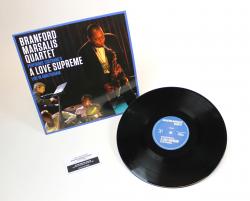 Coltrane’s A Love Supreme: Live in Amsterdam reissue from the Branford Marsalis Quartet out now and available on vinyl for the very first time Read more »
Coltrane’s A Love Supreme: Live in Amsterdam reissue from the Branford Marsalis Quartet out now and available on vinyl for the very first time Read more »
Branford Marsalis shows no fear at SummerFest
Publication: UT San Diego
Author: James Chute
Date: August 9, 2012
You have to give Branford Marsalis credit: he has absolutely no fear.
It was probably pretty scary when he joined Art Blakey’s famed Jazz Messengers while still a student. And he undoubtedly he had some frightful moments while musical director of the Jay Leno’s “Tonight Show.” Then there were the times he performed with the Grateful Dead.
But that’s nothing compared to the challenge Marsalis set for himself at SummerFest Wednesday at Sherwood Auditorium in four songs by Samuel Barber, but especially in Hindemith’s Trio for Tenor Saxophone, Viola and Piano and Busch’s Quintet in E Major for Strings and Alto Saxophone. The “classical” first half was followed by a second half “jazz” set that seemed by comparison a walk in the park.
There’s a reason why Hindemith is not on top of the anybody’s classical hit parade. It’s thorny, demanding, off-putting music. Marsalis’ skilled collaborators, Jeffrey Kahane and violist Paul Neubauer, didn’t do much to counter that impression. In the extended keyboard solo that opens the work, Kahane treated the piano like a percussion instrument and Neubauer’s playing also tended toward the aggressive.
But in the middle of it all, a calm Marsalis seemed to search for the lyricism in Hindemith’s music. He looked for a way to make it sing, and the interpretation succeeded to the degree he was able to get his colleagues to bring out Hindemith’s more lyrical aspects.
In the transcriptions of four songs by Barber, Marsalis was able to tap into Kahane’s more sensitive, relaxed side, and together they made a persuasive case for these miniature gems (“The Monk and His Cat,” “St. Ita’s Vision,” “Nocturn” and “Nuvoletta”).
In the Busch Quintet, Neubauer and violinist Arianna Warsaw-Fan, with the Tokyo String Quartet’s first violinist Martin Beaver and cellist Clive Greensmith, provided Marsalis with able support, particularly in the final movement Andante sostenuto, where again, Marsalis and his colleagues emphasized the sustained melodic lines.
The concert’s less-structured second half seemed to provide a release for Marsalis. He let loose with torrent upon torrent of notes, as if he had been holding them back and they just had to get out.
Rather than his usual quartet, one of its members, bassist Eric Revis, backed him up. But that was all he needed. Revis was a one man rhythm section, or to be more specific, in “Tiger Rag” he was a one-man New Orleans band and in “It Don’t Mean A Thing (If It Ain’t Got That Swing),” he was a one man big band.
Marsalis has assimilated his many influences, from Sonny Rollins to Sting, into a distinct style in which not a note (and there are plenty of them) is wasted and every phrase has a clear direction.
He’s never playing for the sake of playing. He’s got a destination in mind and it’s energizing to be on the journey with him.
Categories
Tags in Tags
Branford Marsalis Branford Marsalis Quartet ellis marsalis four mfs playin' tunes Joey Calderazzo Justin Faulkner Marsalis Family marsalis music metamorphosen miguel zenon music redeems new orleansFilter by Artist
Marsalis Music Radio
Join Our Mailing List
- RT @bmarsalis: Compliments of the @T_Blanchard archives. https://t.co/4RsXbyEloa — 1 year 25 weeks ago MarsalisMusic